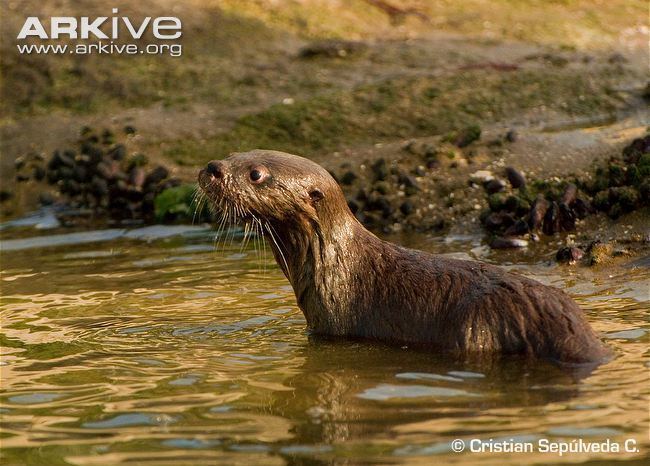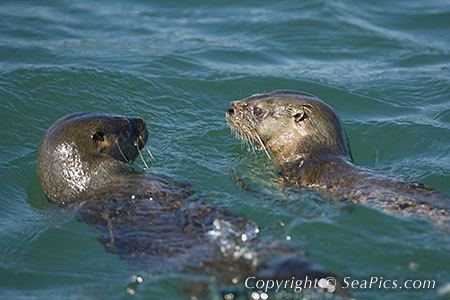Subfamily Lutrinae Gestation period 60 – 70 days Rank Species | Phylum Chordata Genus Lontra Mass 3 – 5.8 kg Higher classification Lontra | |
 | ||
Length 83 – 110 cm (Without Tail) Similar Otter, Southern river otter, Spotted‑necked otter, Mammal, African clawless otter | ||
Otters gone wild mote marine otter fight
The marine otter (Lontra felina) is a rare and poorly known South American mammal of the weasel family (Mustelidae). The scientific name means "otter cat", and in Spanish, the marine otter is also often referred to as gato marino: "marine cat". The marine otter (while spending much of its time out of the water) only lives in saltwater, coastal environments and rarely ventures into freshwater or estuarine habitats. This saltwater exclusivity is unlike most other otter species, including the almost fully aquatic sea otter (Enhydra lutris) of the northeast Pacific.
Contents
- Otters gone wild mote marine otter fight
- Marine otter and harbour seal at fisherman s wharf victoria
- Description
- Distribution and habitat
- Feeding
- Behavior and reproduction
- Conservation status
- References

Marine otter and harbour seal at fisherman s wharf victoria
Description

Marine otters are relatively small, and among otters, only the oriental small-clawed otter is smaller. However the latter species inhabits freshwater sites; thus the marine otter is the smallest exclusively marine mammal on Earth. Lengths range from 83 to 113 centimetres (33 to 44 in), not counting the tail of 30 to 36 centimetres (12 to 14 in). Weights can range from 3 to 5.8 kilograms (6.6 to 12.8 lb). Their fur is dark brown on the back and light brown on belly. The guard hairs cover short insulating fur with a grayish color. The fur is coarser and tougher than in sea otters.
The front and hind paws are webbed, and there are four teats.

The marine otter's lower jaws contain eight pairs of teeth, and the upper jaws eight or nine pairs. The teeth are developed for slicing rather than crushing.
Sexual dimorphism in this species not readily apparent.
Distribution and habitat

Marine otters are found in littoral areas of southwestern South America, close to shore and in the intertidal areas of northern Peru (from the port of Chimbote), along the entire coast of Chile, and the extreme southern reaches of Argentina. Occasional vagrant sightings still occur as far afield as the Falkland Islands.

The marine otter mainly inhabits rocky shorelines with abundant seaweed and kelp, and infrequently visits estuaries and freshwater rivers. It appears to select habitats with surprisingly high exposure to strong swells and winds, unlike many other otters, which prefer calmer waters. Caves and crevices in the rocky shorelines may provide them with the cover they need, and often a holt will have no land access at high tide. Marine otters avoid sandy beaches.
Feeding
Little is known about the diet of marine otters, but their primary prey is believed to be crab, shrimp, mollusks, and fish.They also eat many types of crustaceans.
Behavior and reproduction
Marine otters are most often seen individually or in small groups of up to three. They are difficult to spot, swimming low in the water, exposing only their heads and backs. It is not known whether they are territorial, as males are occasionally seen fighting, yet fights have also been observed even between mating pairs. Fighting takes place on prominent rocks above the waterline, which are also used for resting, feeding, and grooming. Marine otters have also been observed feeding cooperatively on large fish, but it is not known how common the practice is.
The otters are diurnal.
Marine otters may be monogamous or polygamous, and breeding occurs in December or January. Litters of two to five pups are born in January, February or March after a gestation period of 60 to 70 days. The pups remain with their mother for about 10 months of parental care, and can sometimes be seen on the mother's belly as she swims on her back, a practice similar to that of the sea otter. Parents bring food to the pups and teach them to hunt.
Conservation status
Marine otters are rare and are protected under Peruvian, Chilean, and Argentine law. In the past, they were extensively hunted both for their fur and due to perceived competition with fisheries. Hunting extirpated them from most of Argentina and the Falkland Islands. Poaching is still a problem, but one of unknown magnitude. It is unknown how many marine otters exist in the wild or what habitats should be preserved to encourage their recovery. Marine otters were listed under CITES Appendix I in 1976, and are listed as endangered by the U.S. Department of the Interior.
